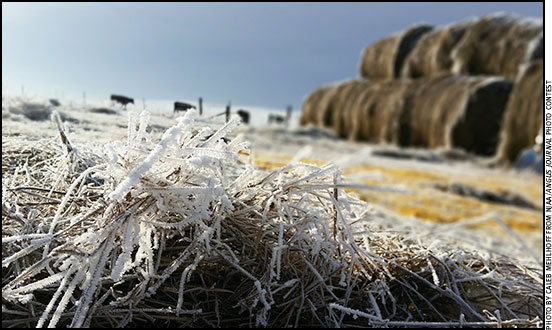
Stretch Hay Supplies
MU beef nutritionist advises cattlemen facing questionable hay supplies to ‘feed less, need less.’
As winter feeding season continues with a forecast of arctic weather in February, cow-calf operations face questionable hay supplies. Eric Bailey, University of Missouri (MU) beef nutritionist, gives the short answer: “Feed less, need less.”
In practice, that takes management decisions and exacting math.
Reduce the need
The “need less” part means selling cows. That makes fewer mouths to feed. Selling some cows may be beneficial as it puts the stocking rate in synch with the carrying capacity of the farm.
If a cow isn’t carrying a calf, she shouldn’t still be in the herd, Bailey says. That makes pregnancy checks a useful starting point.
Cows with bad attitudes or poor production are also good candidates to send down the road. Again, it’s fewer mouths to feed.
“No cow should be given a second chance,” Bailey says. If she fails to conceive in your farming system, she’ll likely fail on retry. Keeping bad cows builds a mediocre herd.
Precision feeding
In his MU Extension talks to farmers, the nutrition specialist goes beyond talking vitamins and minerals to offer management tips that cut costs. He urges dealing with big problems first.
When feeding hay, match the amount fed to the body needs of the cow. Is it an 800-pound (lb.) bale or a 1,200-lb. bale? Is it a 1,000-lb. cow or half again more in body weight?
Rations are based on the cow’s body weight. As a general rule, a cow will need the equivalent of 3% of her body weight in hay per day.
Consider a 900-lb. bale and a 1,400-lb. cow as an example. A little math (1,400 ✕ 0.03) indicates each cow needs 42 lb. of hay per day. That lets one bale feed 22 cows. However, not all hay is the same quality. Hay testing allows fine-tuning needs.
A mid-gestation cow needs a ration of 55% total digestible nutrients (TDN). A cow that calved and is nursing needs 65% TDN. That mid-gestation cow needs only 7% crude protein (CP), while the lactating cow needs 11% CP.
Reduce waste
Oh, then there’s hay waste to calculate. Feeding cows requires precision to stretch hay supplies.
Some tips: Roll out only a day’s worth of hay at a time, Bailey advises. Then cut hours of access to that hay. With three hours of access, a cow wastes 6 lb. of hay per day. Given 24-hour access, she wastes nearly 14 lb. a day.
Feeding less hay may take buying and feeding supplement. Feed needs can be met in part by plentiful low-cost byproduct feeds. Those are feeds left in making biofuels, whether ethanol or soy oil. A ration fed at 1% of body weight can be half grain (such as corn) and half byproduct.
Bailey used the MU Extension weekly byproduct feed report published within the Missouri Beef Resource Guide on MU’s AgEBB (Ag Extension Bulletin Board) website (http://agebb.missouri.edu/) even before he came to Missouri.
Feeding management starts with knowing how many days of hay are left. Then herd owners must know what it takes to maintain different animals in the herd.
Counting cows doesn’t provide an answer on how much hay will be needed. Feeding is based on body weight of animals.
Bailey, who came to Missouri after working in the Southwest, grew up on a New Mexico ranch.
With that background, he says Missourians have great resources for beef cow herds. Plentiful grass and hay grow here. Supplements are plentiful and low-cost.
Last year an ag drought across much of Missouri reduced grass growth and fall stockpiles. While hay may be short, feed is plentiful, he says.

Editor’s Note: Duane Dailey is a writer for University of Missouri Extension.






